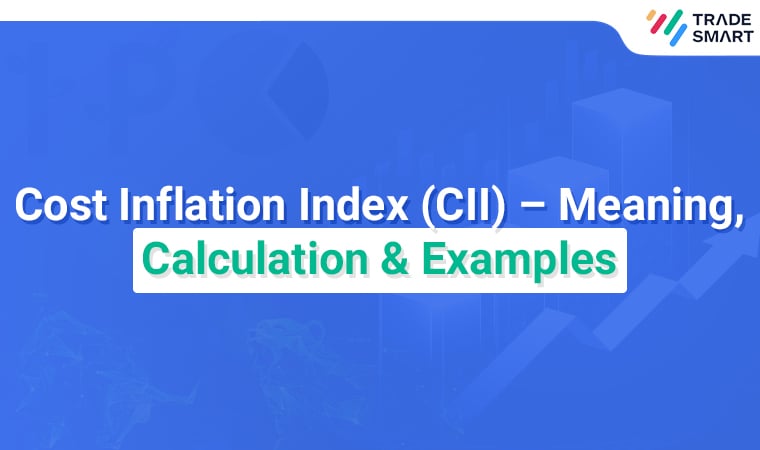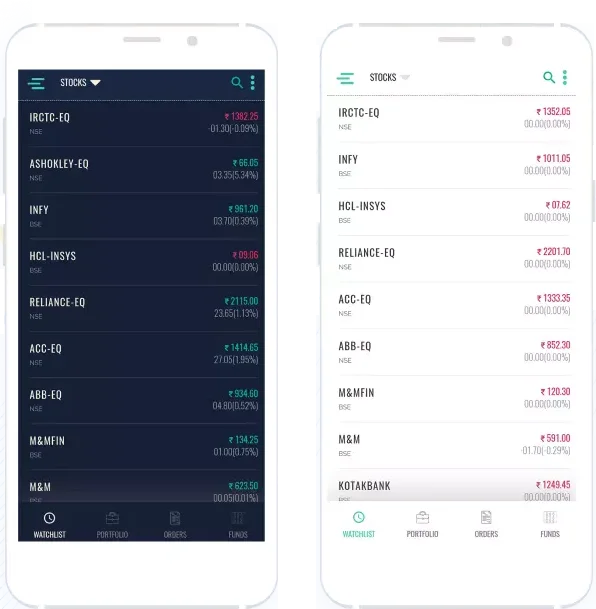Cost Inflation Index (CII) – Meaning, Calculation & Examples
Mar 04 2022 7 Min Read

The current scenario
As always, our world economy has never ceased to be dynamic and is always subject to constant changes. This variation is evident from the fall in the purchasing power of money because of the existing rise in the prices of goods and other services. The principle of a decrease in the value of money, which increases a person’s lifestyle expenses, is known as inflation.
What is the Cost Inflation Index?
The Cost Inflation Index or CII is a method used to calculate an approximate yearly increment in an asset’s price due to inflation. The central government sets the index level and displays it on the official central gazette for measuring inflation. This index is updated each year by the government according to the procedure mentioned under Section 48 of the Income Tax Act, 1961.
Why do we need CII?
A Cost Inflation Index table is prepared to calculate the long-term capital gains from the transfer or sale of any capital asset. Capital gains are nothing but the profit realised after the sale or transfer of any capital asset, including property, stocks, land, shares, patents, trademarks, etc.
While maintaining accounts, generally, a long-term capital asset is held at its cost price in books. So, despite the price risings of assets, the capital assets do not get re-valued.
Hence, during the event of the sale of an asset, the profits or gains realised from these assets remain elevated due to a higher sale price in contrast to the original purchase price. A person also tends to pay a higher income tax on the gains from these assets.
With the use of the Cost Inflation Index in case of capital gains, for the long term, the purchase price of an asset is iterated according to its sale price, resulting in a lower profit and thus lower tax amount to be paid to the government.
The Central Board of Direct Taxes (CBDT) in February 2018 brought in the new Cost Inflation Index numbers for the term from 2017-18 onwards. In this update, there was a move from the old base year of 1981 onto 2001, with 100 fixed as its CII. The indices for the upcoming years also got updated sequentially.
This update in the base year was brought into effect to solve the problems posed to taxpayers in calculating total tax payable for gains through capital assets purchased on or before 1981.
So, CII is used to measure the inflation-adjusted cost price of an asset. The inflation-adjusted price is then implemented to get the long-term capital gains or losses. The CII is used to find the inflation-adjusted price of an asset such as building, land, gold, house, jewellery, stocks, mutual funds, etc. Although, it cannot be applied to equity shares and equity mutual funds whose capital gains are taxable at a rate of 10 percent without the indexation benefit.
When filing income tax returns (ITR), this CII number can significantly help you index the long-term capital gains you have to pay the taxes.
The Central Board of Direct Taxes or the CBDT updated the cost inflation index or the CII for FY 2021-22 as 317 through a notification on date June 15, 2021. For the past year, i.e., FY 2020-21, CII was updated as 301.
As per the recent update, CII for FY 2021-22 came into effect from April 1, 2022, and will apply to the assessment year 2022-23 and consequently to upcoming assessment years.
Instances When Indexation Benefit is Not applicable
According to our above discussion, a Taxpayer cannot get the benefit of indexation for long term capital gains in case of transfer of the following assets:
- Equity shares of a company where STT has been given on the transactions related to the buying and, or transfer.
- Parts of an equity-based fund where STT has been paid off in the transfer of its units
- Parts of a company’s trust where STT has been paid off in the transfer of its units
- Bonds and, or debentures other than for capital indexed bonds issued by the Government of India and sovereign gold bond (SGB) issued by the RBI
- Non-Resident Indians (NRIs) cannot claim any indexation benefits in terms of stocks or bonds/debentures of any Indian company acquired by their foreign currency.
Cost Inflation Index Chart:
Below is the updated cost inflation index chart for the last ten financial years.
| Financial Year | Cost Inflation Index |
| 2001 – 02 (Base Year) | 100 |
| 2002 – 03 | 105 |
| 2003 – 04 | 109 |
| 2004 – 05 | 113 |
| 2005 – 06 | 117 |
| 2006 – 07 | 122 |
| 2007 – 08 | 129 |
| 2008 – 09 | 137 |
| 2009 – 10 | 148 |
| 2010 – 11 | 167 |
| 2011 – 12 | 184 |
| 2012 – 13 | 200 |
| 2013 – 14 | 220 |
| 2014 – 15 | 240 |
| 2015 – 16 | 254 |
| 2016 – 17 | 264 |
| 2017 – 18 | 272 |
| 2018 – 19 | 280 |
| 2019 – 20
2020 – 21 2021 – 22 |
289
301 317 |
What do you mean by the Base Year in CII?
The base year is the foremost year in the index whose value is fixed at 100. The indexation of years after the base year is done according to the base year to track their increase in the inflation levels. In case of any capital asset bought before the base year of the cost inflation index, taxpayers may assume the purchase price as higher than the actual cost or Fair Market Value (FMV) on the 1st day of the base year. Indexation benefit applies to the purchase price of such calculated purchases. FMV is found based on the valuation report of a certain registered valuer.
Why was the base year for the Cost Inflation Index changed to 2001 from 1981?
In the early days, 1981-82 was set as the base year. However, taxpayers faced many problems to value their properties purchased before April 1, 1981. Tax authorities in India also found it complex to depend on the then valuation reports. So, the Government finally decided to change the base year to 2001 to rapidly and effectively valuations. Thus, for a capital asset purchased before April 1, 2001, taxpayers can now use higher of the actual cost or FMV as of April 1, 2001, as its purchase price and get the benefit of indexation.
How is Indexation really applicable on Long Term Capital Assets?
Indexation is applicable for the cost of asset acquisition to adjust the price of assets according to inflation. Long-term capital assets are recorded at cost price on paper. Despite increasing inflation, these assets are set at the cost price, and their value remains constant. During the sale of such assets, the profit amount remains high as the higher selling price is compared to the purchase price. This means a higher income tax as well. The cost inflation index is used at the long-term capital assets, meaning its purchase price increases, reducing the realised profits, meaning lesser taxes to benefit the taxpayers. The cost inflation index benefit is made applicable to the long-term capital assets, because of which purchasing price increases, resulting in fewer profits and lower taxes.
Following formula is made use of to find indexed cost of asset acquisition:
Indexed cost of asset acquisition = The CII for the year of sale or transfer* (Cost of asset acquisition)/ CII for the first year for the holding period of asset or year 2001-02, considering the later one.
Following formula is made to find the indexed cost of asset improvement:
Indexed cost of asset improvement = CII for year of sale or transfer*( Cost of asset improvement)/ CII for the year during which the asset got the improvement.
How can the benefits of Indexation be used to reduce Tax Liabilities on Long Term Capital Gains for Taxpayers?
To understand this topic in detail, we consider an actual case for the FY 2019-2020, in which The Central Board of Direct Taxes or CBDT had fixed the Cost Inflation Index for FY 2019-20 at 289, updating it from 280, which was the CII in FY 2018-19. As we understood, CII is used to determine the inflation-adjusted cost of asset acquisition to calculate Long Term Capital Gains on assets appreciating. The indexation process can help reduce the tax burden for the same.
Taxpayers can pull down their total sum of tax liabilities on their realised long-term capital gains from the transfer of assets like debt mutual fund properties, real estate, etc. Estimating the entire amount invested according to the cost inflation index asset bought and sold years. This can also be done with the help of a cost inflation index calculator online.
Now, let us consider, a taxpayer realises capital gains from either transfer or sale of, say, a land will attract applicable taxes on capital gains, whether long or short term. If the holding period of this land is less than 24 months, then the profits or gains realised from such a transfer or sale of this asset will be considered a short-term capital gain, and this is not applicable for Indexation. But, if the person has held the asset for more than 24 months during the transfer or sale, they are taxed at a rate of 20%, with the Cost Inflation Index being applicable.
When the Cost Inflation Index is used to gain on the property, the sum of the profit is voluntarily deducted. So, the amount on which taxes would be applicable also gets reduced, thus minimising a person’s tax liabilities on Long Term Capital Gains.
Reducing one’s tax liabilities is one of the primary reasons for the increase in the demand and issuing of bond or debt funds and the Fixed Maturity Plans (FMP). The utilisation of the Cost Inflation Index on Long Term Capital Gains can help taxpayers save after all tax dues on long-term gains, which they can then use to invest in the various financial products. In this way, the taxpayers can have surplus savings and propel their wealth by investing the surplus sum, building their wealth and the nation.
Who updates the Cost Inflation Index?
The Central Government notifies the cost inflation index by updating the value in their official publication.
Roughly calculated as, Cost Inflation Index = 75%* the average rise in the Consumer Price Index (urban) for the most recent year.
The Consumer Price Index here accounts for the current price of a range of goods and services that represent the economy with the cost of the same range of goods and services in the past year to find the increase in prices.
Things to remember about Cost Inflation Index:
While finding out the indexed cost of asset acquisition, there are a few critical points one should keep in mind:
- If the asset is received at an individual’s will, the Cost Inflation Index will be considered for the year when it was received. The asset’s actual purchase year should be ignored in the current case.
- The improvement cost experienced before April 1st, 2001 is not applicable for indexation.
- The benefit of indexation is not applicable for debentures or bonds, apart from those issued by the RBI bonds, including the sovereign gold bonds or the specialised capital indexation bonds.
Frequently Asked Questions
Index cost of a property = Cost of Acquisition * (CII of the year of transfer or sale)/ CII of the year of acquisition
The inflation index is notified by the government of India every year during the finance budget.
According to the laws governing income tax, the base year for the Cost Inflation Index is FY 2001-02. Previous to this amendment made by the Finance Act of 2017, the base year was FY 1981-82.

